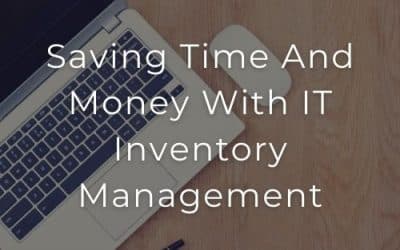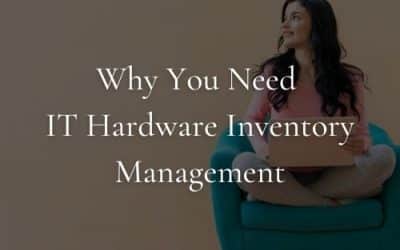IT hardware inventory management involves you and your team managing every aspect of your IT hardware. You need to do all of these things effectively to make purchasing decisions, deal with security issues, and solve problems. Unfortunately, searching through receipts and asking employees about their IT hardware can take a lot of time.
Here is where IT Hardware Inventory Management can make a huge difference to your working day. You can organise your inventory so that those all-important documents are easy to find.
What is IT Hardware?
IT hardware consists of computer inventory, routers, servers, hubs, switches, and any other IT equipment that you use. Hardware such as this is crucial when it comes to running your business.
Chances are you have a lot more IT hardware than you realise. Most of us tend to have hardware such as this in our homes. Businesses, therefore, are likely to have a considerable amount of hardware. Keeping track of IT hardware may be harder than you may have originally thought. every employee may have been assigned a computer, router, or other hardware, that they are required to use every day. This is essentially why IT Hardware Inventory Management is a much-needed tool.
What is an IT Hardware Inventory
An IT hardware inventory consists of every piece of hardware that a business owns or leases. Hardware such as this could be worth considerable sums of money. An inventory can detail exactly how much equipment the business has. It can also include where the hardware is located, its maintenance status, and many other details. itemit’s IT hardware inventory can include a range of details such as the hardware’s:
- Barcode
- Subscription details, including start date
- Cost and current value
- The manufacturer’s warranty information
- Maintenance schedule
- Location
- Owner
- Insurance details
- Previous and current user
- Remaining life
- The start date of the licence, if required
When all of these pieces of information are entered into an inventory, they can potentially improve or solve inventory management issues. Users will no longer need to search their offices for receipts, maintenance schedules, or any other required details. itemit has the capacity to make tracking all hardware very easy.
Taking the guesswork out of managing all aspects of IT Hardware Inventory Management can make a considerable difference. Business owners can concentrate on running other areas of their businesses.
Why You Should Manage Your IT Hardware Inventory

IT Inventory Management is vital to your business if you want to reduce incidences of theft or items going missing. Further reasons include allowing you to:
- Assign particular assets to your employees. You’ll be able to track who currently has the IT hardware and who had it previously.
- Track the location of all of your IT hardware. Hardware can be moved from time to time, but using tracking software ensures that you know where it is at all times.
- Have more control over the maintenance schedule. Keeping all of your IT hardware in good working order is essential. Knowing when pieces of equipment need to undergo maintenance allows you to keep them in the best possible working order.
- Organise your inventory levels. If you have 200 employees, for example, you may need 200 computers. Knowing you have enough computers for everyone means each employee has the tools to work effectively.
- Improve security. IT hardware is less likely to go missing if it is tracked. Hardware that is removed from the premises can be tracked closely 24 hours a day, every day.
- Receive real-time updates. Business owners can receive constant updates about the location of the IT hardware, view updated photographs, and read notes that have been left about the hardware.
- Eliminate the risk of ghost assets. IT hardware that is always updated in its status is less likely to need replacement. Additionally, thanks to the tracking software, IT hardware is less likely to go missing.
All of these factors can help every business owner have more control over every asset, making their business run much more smoothly. Businesses can be hard enough to run. When there is little control over expensive hardware, profits can be affected.
How You Can Manage Your IT Hardware
From maintenance to planning upgrades, properly managing IT hardware requires a disciplined approach to guarantee everything operates as it should. Hardware inventory management is a fundamental part of this process since it tracks every physical item in your IT setup.
Creating a Detailed Inventory: The Foundation of Success
Creating a thorough software and hardware inventory is the first step in underlining your IT infrastructure management. Maintaining a thorough log of all your equipment—servers, computers, peripherals, and network devices—allows you to control assets effectively. In my experience, using hardware inventory software guarantees tracking key information such as purchase dates, warranty durations, and serial numbers.
Your management plan revolves mostly around this computer hardware inventory. Knowing exactly what you have, where it is, and its condition helps you make replacement plans before problems start. This also helps with future purchase budgeting and avoidance of unanticipated expenses.
Regular Maintenance and Updates for Longevity
Regular maintenance is absolutely essential to maximise your hardware. This covers more than just simple cleaning; it also guarantees the currentness of firmware and software. Arranging these updates helps to lower the possibility of security flaws or performance problems. By means of a computer inventory management system, one may guarantee that no equipment is missed throughout the updating process.
Furthermore, using monitoring tools included within your equipment inventory system will give your gadgets real-time data on condition. Alerts warning of ageing hard drives or hot servers help to avoid expensive downtime.
End-of-Life Planning for Seamless Transitions

Every bit of hardware finally approaches its end of life (EOL). How this is planned affects how disturbances are avoided. Good computer hardware inventory management systems enable one to monitor when manufacturer support is going to stop and when devices are nearing their EOL. This realisation lets you replace or update machinery before it becomes a liability.
Apart from replacing old gear, its safe disposal is also quite important. Make sure any sensitive information is correctly erased before throwing away obsolete devices to stop security leaks. Your equipment inventory management method should naturally include this.
Scalability and Future-Proofing for Growth
Your IT system must remain current as your company expands. One typical mistake I have noticed is companies buying hardware that satisfies just their present needs without thinking through future needs. Think ahead and make investments in scalable solutions while handling your computer hardware inventory. Modular hardware, virtualised environments, and cloud services help to smooth future development.
Using hardware inventory software facilitates the prediction of demands based on past data and usage trends, therefore guiding wise purchase selections.
Security and Backup Measures
In IT management, security always looms large. By spotting unpatched or outdated software on your network, your software inventory tracking keeps current and reduces risks. Simultaneously, actual gear needs to be locked via regulated access points, encryption, and firewalls.
The management of IT infrastructure also depends heavily on backup mechanisms. Including automated backups into your equipment inventory system guarantees consistent data saving in onsite and remote locations. This is absolutely essential for fast recovery in case of hardware breakdown or a cyberattack.
Energy Efficiency: Cutting Costs Where It Counts
Hardware management goes beyond performance to include maintaining cost control, particularly with regard to energy use. Energy-efficient solutions might help you more properly control the considerable resource drain that IT equipment causes. Using computer inventory management, for example, allows you to monitor which devices consume the most power and substitute more effective models.
Over time, using low-power modes or automated shutdowns during off-peak can also result in major cost savings.
Vendor Management: A Key to Better Support

I now find that keeping close ties to hardware providers can be quite beneficial. For long-term clients, your suppliers can give discounts; they can also offer guidance on the newest trends and help to solve problems. Maintaining track of vendor warranties and support contracts guarantees that, when handling your computer hardware inventory, you can seek assistance as needed without delay.
A strong vendor relationship can also facilitate more tailored solutions or support extensions, making hardware management even smoother.
Training Employees for Effective Hardware Use
Your hardware’s sophistication notwithstanding, it will only be as good as the people using it. Workers must receive instructions on the correct handling and maintenance of the tools. Your equipment inventory management should include teaching users how to solve minor problems and avoid actions that can shorten hardware lifetime.
Familiarisation with computer hardware inventory management systems should also be part of training so everyone knows how to document problems or ask for upgrades when needed.
Disaster Recovery Planning
You have to prepare for the worst even while you should hope for the best. Your hardware inventory management policy should incorporate a well-organised disaster recovery plan. This strategy should detail steps for restoring services, who is in charge of each activity, and how hardware repairs or replacements will be handled.
Think about putting up backup servers for important hardware—that is, ones that might take over should the main ones fail. With this strategy, your operations may continue with the least disturbance, even in case of tragedy.
Monitoring and Analytics: The Key to Efficiency
You must actively track performance if you wish to maximise your hardware management. Including analytics tools in your computer hardware inventory can help you understand your systems’ operational state. Tracking performance indicators, including CPU load, storage use, and network traffic, helps you find and fix inefficiencies before they affect output.
Frequent study of this information guarantees wise judgments when updating current systems or buying new hardware. It also helps prevent overinvesting in fields unlikely to be in demand.
Benefits of Software Inventory Tracking

Software inventory tracking is one element sometimes disregarded yet is absolutely essential for operational effectiveness. From strengthening security to bettering budget management, this habit provides many advantages and is necessary to have a running IT infrastructure. Let’s explore the main advantages of software inventory tracking and how much it can change your company.
Improved Licence Management
Improved licence management is one of the direct benefits of software inventory tracking. Many companies struggle with manually tracking software licences, which can result in either underutilising purchased licences or, worse, employing software without appropriate permission. Using server inventory software will let you automatically monitor your own licences, their deployment, and expiration dates.
This will help you avoid overbuying licences, avoid audit penalties, and guarantee licence compliance. Effective tracking also allows you to find abandoned or underused licences and distribute them to where they are most needed, therefore optimising your software expenditures.
Enhanced Security and Compliance
Security concerns exist higher than ever; hence, maintaining your business depends on keeping your software current. Monitoring all software installations on your network enables software inventory tracking to assist you in finding insecure or obsolete programs that require repair. Maintaining security depends on having a whole picture of your hardware and software environments, which is obtained by combining hardware inventory software with your software inventory tracking.
Regular audits, using software track inventory solutions, help guarantee that every installed software conforms to industry standards and corporate security requirements. This preventive strategy lowers your system’s risk of security vulnerabilities resulting from obsolete or illegal software.
Cost Savings and Budget Optimisation
Effective software inventory tracking systems can cut running expenses greatly. Knowing exactly what program you have and how it is being utilised will help you make better decisions on renewals, upgrades, or cancellations. Should any programs be underused, you can either allocate those funds or remove pointless licences, therefore directly affecting your bottom line.
Furthermore, you may control your digital assets just as successfully as your physical ones by combining your software inventory tracking with fixed asset tracking software. This all-encompassing strategy helps maximise your whole IT budget and stops pointless spending on duplicate or obsolete programs.
Streamlined IT Operations
Including server inventory software and equipment inventory software in your toolkit for IT administration can help simplify daily tasks. Having a real-time view of all installed programs helps you far more easily maintain your systems and guarantee their efficient running. Before they create major disruptions, this strategy also helps IT departments to rapidly find and fix problems with obsolete or failing software.
Software inventory tracking also gives IT departments the tools they need to allocate resources properly. Knowing which departments or projects use specific software helps prioritise maintenance and upgrade activities, reducing disruptions and enhancing performance generally.
Simplified Software Upgrades and Patch Management
Manually managing software upgrades might take time, especially if your company has many devices or users. Implementing software inventory tracking helps automate most of the update and patch management tasks. This guarantees that no system is left unprotected because of antiquated software and that all important updates are executed on time.
Software track inventory solutions can also let you know when specific programs reach end-of-life or are no longer supported, enabling you to make well-informed updates far in advance. By being proactive, you reduce downtime and maintain seamless business operations.
Improved Decision Making
Making wise selections depends on accurate data, particularly regarding software purchases. Software inventory tracking offers comprehensive reports and insights into software usage, guiding your knowledge of which programs are absolutely essential for your operations and which ones might no longer be so.
Combining hardware inventory software with software inventory software provides a complete picture of your IT system, including hardware and software. This helps you make smart decisions about updates, future acquisitions, or decommissions based on real-use statistics instead of speculation. This degree of understanding maximises resource allocation and enhances general corporate agility as well.
Minimised Downtime
Any company can find downtime to be rather expensive; one of the main causes is software malfunction. Using software inventory tracking to monitor the state and performance of every application can help you avoid unanticipated problems before they start. Maintaining operational continuity depends on knowing when programs should be upgraded or replaced.
Regular audits, such as software track inventory solutions, help identify possible issues early on, ensuring the dependability and functionality of your systems. In my experience, even when software needs to evolve, this proactive maintenance helps your company remain functioning and lessens the possibility of downtime.
Compliance with Licencing and Legal Requirements
Unlicenced software use puts many firms in danger of fines or legal penalties. Monitoring your software inventory tracking system closely helps guarantee compliance with all legal and licencing criteria. This is especially crucial for bigger businesses, where illegal software might easily go unnoticed.
Server inventory software can automatically track compliance and notify you of any illegal installations or licence expirations. This not only shields your company from possible legal problems but also shows auditors and stakeholders responsible management of IT resources.
Contact itemit Today
itemit can make IT Hardware Inventory Management incredibly easy. Helping users to track all of their IT hardware assets with no fuss, itemit does all of the hard work. Email our expert team at team@itemit.com. Alternatively, you can sign up for our no-obligation 14-day Free Trial to discover how well our IT Hardware Inventory Management software works.
Hardware Asset Management
Choose a better way to track your assets
Start your free 14-day trial now
Instant access. No credit card details required.
Related articles
Why IT Asset Management Software Is Essential To Remote Working
IT asset management software helps you keep track of your colleagues’ equipment. It is essential in remote working to run effective and transparent audits.
Saving Time And Money With IT Inventory Management
Find out more about how you can save time and money by using IT inventory management software. Track your critical assets with itemit.
Why You Need IT Hardware Inventory Management
Find out more about IT hardware inventory management. Why does your business need an effective IT asset register? Book your free demo itemit today.



